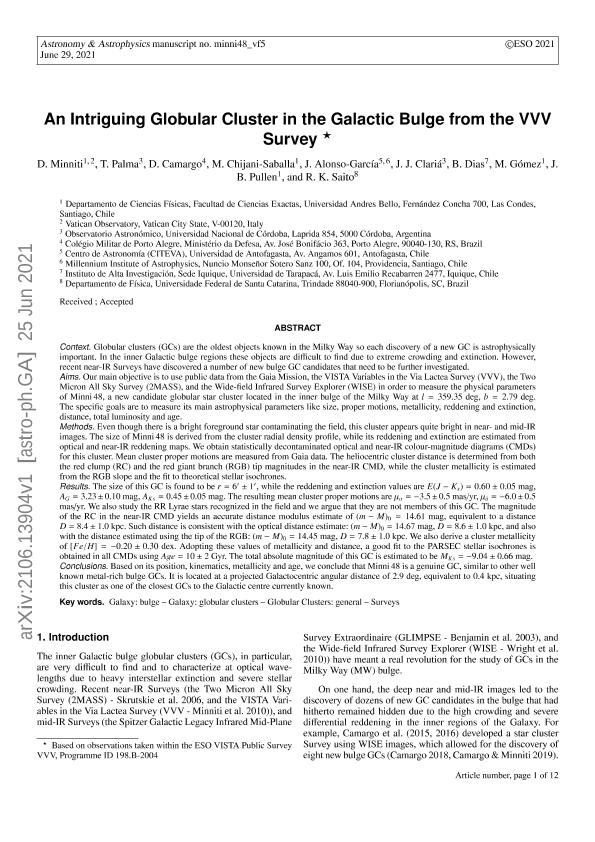Artículo
An intriguing globular cluster in the Galactic bulge from the VVV survey
Minniti, D.; Palma, Tali ; Camargo, D.; Chijani Saballa, M.; García Alonso, José; Clariá, Juan José
; Camargo, D.; Chijani Saballa, M.; García Alonso, José; Clariá, Juan José ; Dias, Bruno; Gómez, M.; Pullen, J. B.; Saito, Roberto
; Dias, Bruno; Gómez, M.; Pullen, J. B.; Saito, Roberto
 ; Camargo, D.; Chijani Saballa, M.; García Alonso, José; Clariá, Juan José
; Camargo, D.; Chijani Saballa, M.; García Alonso, José; Clariá, Juan José ; Dias, Bruno; Gómez, M.; Pullen, J. B.; Saito, Roberto
; Dias, Bruno; Gómez, M.; Pullen, J. B.; Saito, Roberto
Fecha de publicación:
23/08/2021
Editorial:
EDP Sciences
Revista:
Astronomy and Astrophysics
ISSN:
0004-6361
e-ISSN:
1432-0746
Idioma:
Inglés
Tipo de recurso:
Artículo publicado
Clasificación temática:
Resumen
Context. Globular clusters (GCs) are the oldest objects known in the Milky Way so each discovery of a new GC is astrophysically important. In the inner Galactic bulge regions these objects are difficult to find due to extreme crowding and extinction. However, recent near-IR Surveys have discovered a number of new bulge GC candidates that need to be further investigated. Aims. Our main objective is to use public data from the Gaia Mission, the VISTA Variables in the Via Lactea Survey (VVV), the Two Micron All Sky Survey (2MASS), and the Wide-field Infrared Survey Explorer (WISE) in order to measure the physical parameters of Minni 48, a new candidate globular star cluster located in the inner bulge of the Milky Way at l = 359.35 deg, b = 2.79 deg. The specific goals are to measure its main astrophysical parameters like size, proper motions, metallicity, reddening and extinction, distance, total luminosity and age. Methods. Even though there is a bright foreground star contaminating the field, this cluster appears quite bright in near- and mid-IR images. The size of Minni 48 is derived from the cluster radial density profile, while its reddening and extinction are estimated from optical and near-IR reddening maps. We obtain statistically decontaminated optical and near-IR colour-magnitude diagrams (CMDs) for this cluster. Mean cluster proper motions are measured from Gaia data. The heliocentric cluster distance is determined from both the red clump (RC) and the red giant branch (RGB) tip magnitudes in the near-IR CMD, while the cluster metallicity is estimated from the RGB slope and the fit to theoretical stellar isochrones. Results. The size of this GC is found to be r = 6 0 ± 1 0 , while the reddening and extinction values are E(J − Ks) = 0.60 ± 0.05 mag, AG = 3.23±0.10 mag, AK s = 0.45±0.05 mag. The resulting mean cluster proper motions are µα = −3.5±0.5 mas/yr, µδ = −6.0±0.5 mas/yr. We also study the RR Lyrae stars recognized in the field and we argue that they are not members of this GC. The magnitude of the RC in the near-IR CMD yields an accurate distance modulus estimate of (m − M)0 = 14.61 mag, equivalent to a distance D = 8.4 ± 1.0 kpc. Such distance is consistent with the optical distance estimate: (m − M)0 = 14.67 mag, D = 8.6 ± 1.0 kpc, and also with the distance estimated using the tip of the RGB: (m − M)0 = 14.45 mag, D = 7.8 ± 1.0 kpc. We also derive a cluster metallicity of [Fe/H] = −0.20 ± 0.30 dex. Adopting these values of metallicity and distance, a good fit to the PARSEC stellar isochrones is obtained in all CMDs using Age = 10 ± 2 Gyr. The total absolute magnitude of this GC is estimated to be MK s = −9.04 ± 0.66 mag. Conclusions. Based on its position, kinematics, metallicity and age, we conclude that Minni 48 is a genuine GC, similar to other well known metal-rich bulge GCs. It is located at a projected Galactocentric angular distance of 2.9 deg, equivalent to 0.4 kpc, situating this cluster as one of the closest GCs to the Galactic centre currently known.
Palabras clave:
BULGE
,
GLOBULAR CLUSTER
,
SURVEY
Archivos asociados
Licencia
Identificadores
Colecciones
Articulos(CCT - CORDOBA)
Articulos de CTRO.CIENTIFICO TECNOL.CONICET - CORDOBA
Articulos de CTRO.CIENTIFICO TECNOL.CONICET - CORDOBA
Citación
Minniti, D.; Palma, Tali; Camargo, D.; Chijani Saballa, M.; García Alonso, José; et al.; An intriguing globular cluster in the Galactic bulge from the VVV survey; EDP Sciences; Astronomy and Astrophysics; 652; 23-8-2021; 129-138
Compartir
Altmétricas



